| HOME |
|---|
TAURUS
The Bull
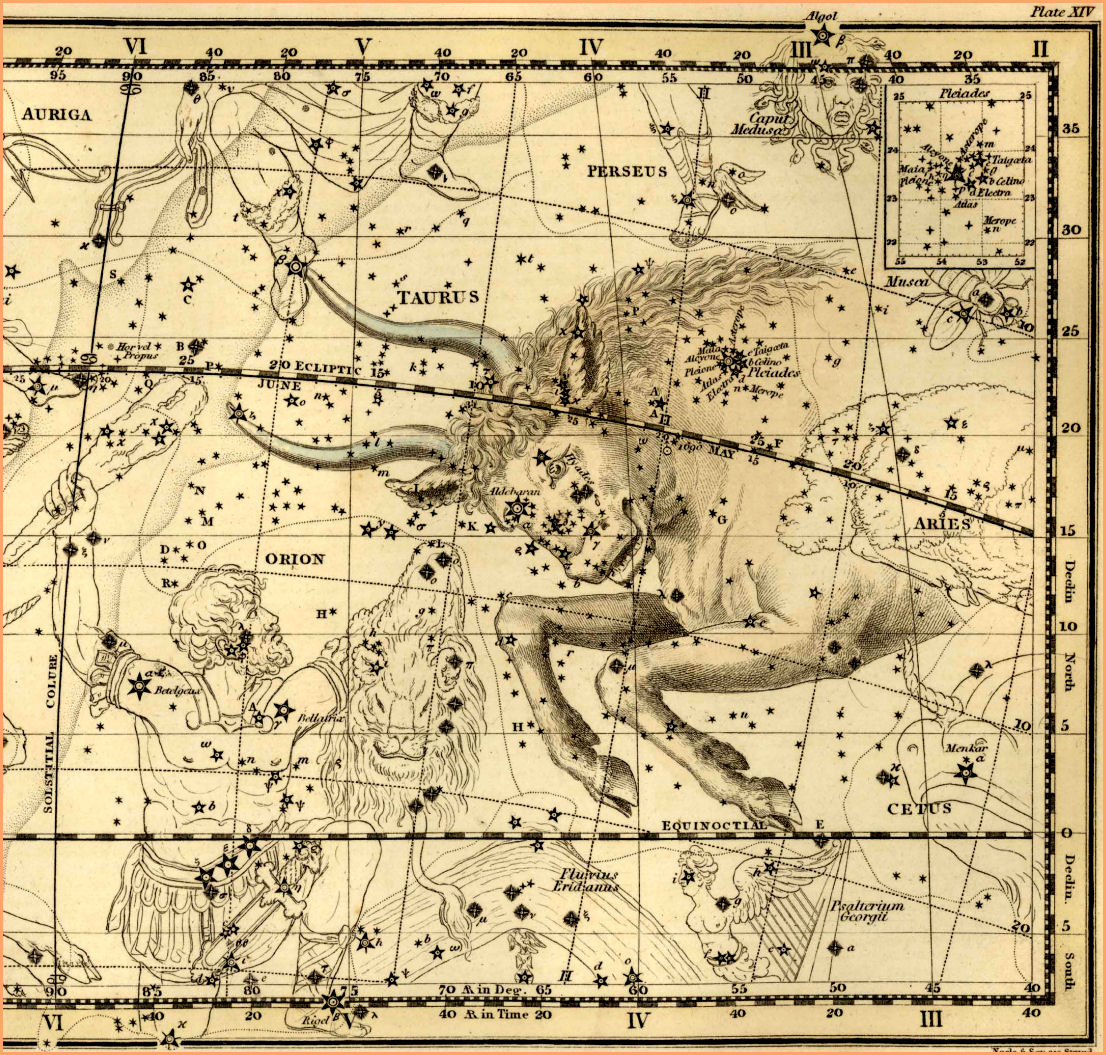
Taurus - Celestial Atlas by Alexander Jamieson - 1822
| HOME |
|---|

Although Taurus and Orion appear to be engaged in a titanic celestial stand-off, there is no mythological connection between them. Taurus, the bull, is quite prepared to stand alone in the sky. Throughout the history of the human species the bull has represented the epitome of strength and dignity. His revered image adorns the caves of Paleolithic man, the tombs of pharaohs, and the halls of kings. Nearly every culture on Earth has classic myths about bulls in their history, and a bull was seen in the stars of Taurus as far back as 4000 BC.
The Greeks had three prominent myths concerning bulls. There was the Creton Bull, battled and defeated by Hercules, and the famous Minotaur, of the labyrinth, slain by Theseus. The myth most often associated with the image in the stars is that of Zeus ( Jupiter) taking on the form of an enormous white bull, and carrying off the maiden Europa - not entirely unwilling - and swimming across the sea to the island of Crete with her. There, Zeus fathered three sons by her, and was so enamoured with her charms he placed the form of the great white bull in the sky to commemorate their unusual courtship. The constellation contains only the head and shoulders of the bull, the rest of his body hidden beneath the waves as he swims the sea.
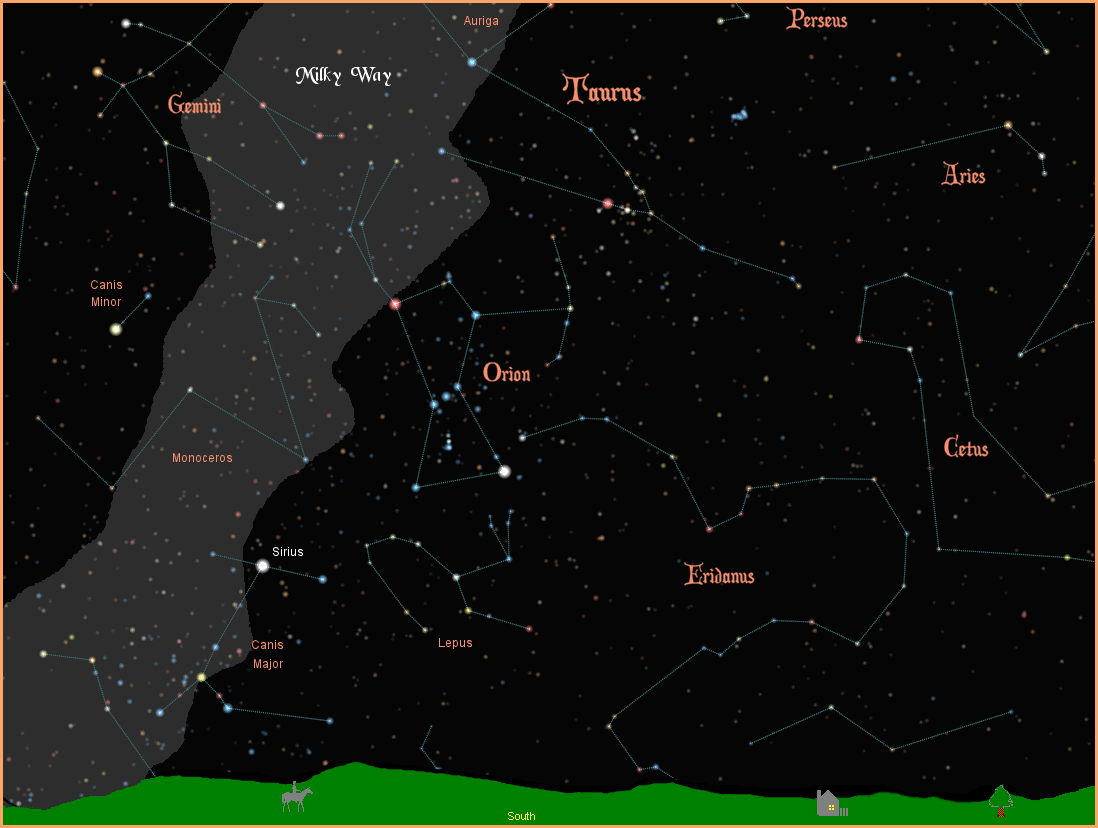
Taurus is dominated by five bright stars that form the base of the famous "V" that defines the bull's head and extends all the way to the tips of his horns. According to legend these stars are the five daughters of Atlas and Aethra, known as the Hyades. Half sisters to the well known Pleiades (the daughters of Atlas with Pleione), the Hyades take their name from their brother, Hyas. It is said that when Hyas died the sisters were so distraught their tears were like rain, and ever since, the appearance of these stars has portended the advent of heavenly showers.
Unlike their nearby siblings, the Pleiades, the stars of the Hyades do not take on the names of the individual sisters. The brightest of the Hyades, Alpha Tauri, the famous fiery red eye of the bull, is named Aldebaran. The name is Arabic for the follower, and once applied to the entire group of stars as it dutifully followed its sister group, the Pleiades, across the sky.
Although traditionally the leader of the Hyades group, Aldebaran technically shares a line of sight connection with them only. The other four bright Hyades stars (along with many more beyond visual range) belong to the Hyades cluster proper, and all reside about 153 light years away, while Aldebaran lies only 67 light years away, almost a hundred light years closer. Aldebaran is a K5III orange giant, 44 times the diameter of the Sun, its magnitude of 0.87 making it the thirteenth brightest star in the sky.
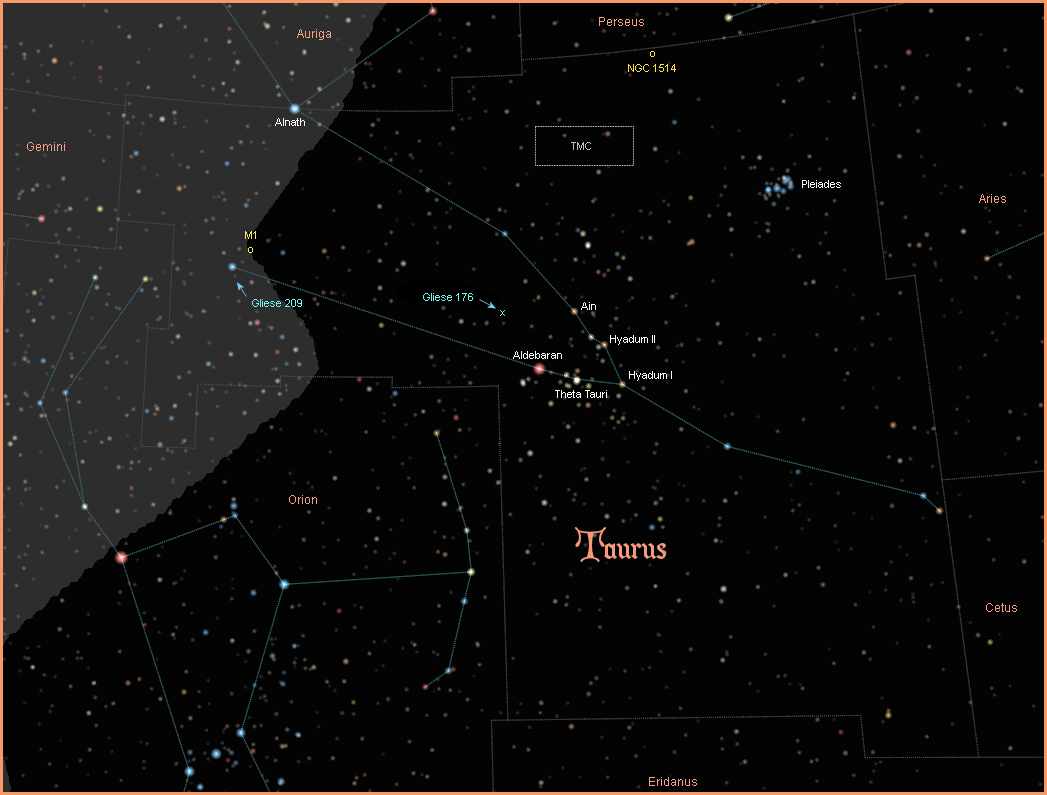
Hyadum I (Gamma Tauri) and Hyadum II (Delta Tauri), the first and second of the Hyades, are almost identical G9III yellow/orange giants, with magnitudes of 3.65 and 3.77 respectively.
Epsilon Tauri is named Ain, Arabic for the eye. It is another G9III yellow/orange giant, slightly brighter at magnitude 3.53. It is also one of the present rarities of a bright naked eye star with a confirmed planet. The planet is more than seven times the size of Jupiter, and orbits its star about twice as far as Earth does.
Theta Tauri is the last of the five bright Hyades and remains unnamed. Appearing as one star to the naked eye, it is an optical double, consisting of two big, bright stars that do not appear to be gravitationally connected. Theta-1 Tauri is designated first, being the westernmost star leading the way across the sky. Like the last three Hyades, it is another G9III yellow/orange giant, with a magnitude of 3.84. Theta-2 Tauri is a slightly brighter A7III white giant with a magnitude of 3.40. Both stars are firmly embedded in the Hyades cluster 153 light years away.
On the tip of the bull's left horn is the second brightest star in the constellation, Beta Tauri, named Alnath, from the Arabic for the butting one. From the time of Ptolemy this star has been shared with the constellation Auriga, and to this day it is an important star in both figures, albeit officially designated as the property of the bull. It is a big, bright B5IV blue subgiant with a magnitude of 1.65, 134 light years away.
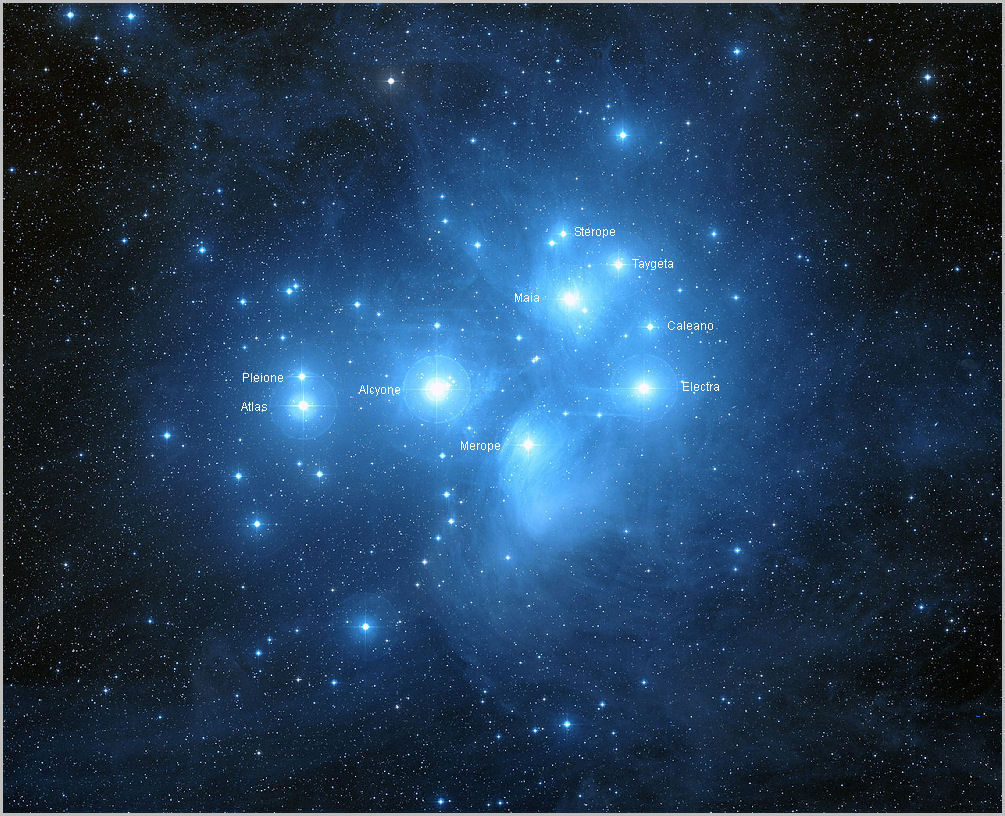
The sparkling Pleiades is the most famous star cluster in the heavens, known since antiquity as the Seven Sisters, daughters of the Titan Atlas and the sea-nymph Pleione. The sisters became mountain nymphs and companions of Artimis (Diana) the huntress. The sisterly star cluster is mentioned in virtually all classical literature and ancient texts, going back thousands of years. Even the Bible includes them -
Although most people see only the six brightest stars in the Pleiades, a telescope reveals hundreds of stars in the cluster, all located about 400 light years away. The entire cluster is enveloped in a vast reflection nebula that glows a ghostly blue, reflecting the light of the hot young blue stars that compose the bulk of the cluster. Analysis has shown the nebula not to be connected to the formation of the cluster, and possibly the ancient remnant of a long lost supernova, drifting through space.
First time observers throughout the ages have been quick to point out that there appear to be only six sisters in the sky, leading to a wealth of speculation as to the missing seventh sister, famously known as "the lost Pleiad". Myths concerning the lost star are surprisingly universal, found all over the globe in many different cultures, supporting the theory that once there was another bright star in the cluster that has long since dimmed significantly. As far back as the third century BC, the Greek poet Aratus wrote:
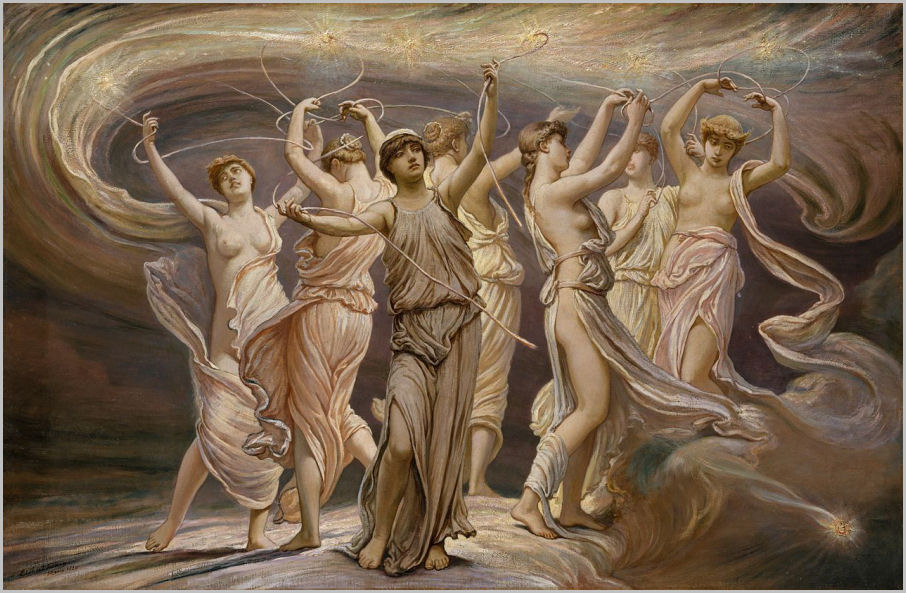
The Pleiades is a young cluster, estimated to be less than 100 million years old, composed mostly of hot, young blue/white stars, of which Alcyone is the premier example. Classified as a B7III blue giant and sporting a magnitude of 2.85, it is the brightest star of the Pleiades, and the only one to be allotted a Bayer designation - Eta Tauri. While it appears as one bright star to the naked eye, Alcyone is actually a complicated multiple star system consisting of no less than five stars. Despite her luminosity and prominence as a star, as a nymph Alcyone's notoriety seems limited to the bearing of offspring by the god Poseidon (Neptune).
20 Tauri is named Maia, after the first born and allegedly the most beautiful of the sisters. Catching the eye of Zeus (Jupiter) and falling prey to his advances, she became the mother of Hermes (Mercury). Her prominence among the sisters suggests that her star may once have been the brightest of the group. At its present magnitude of 3.87 it ranks fourth in luminosity, a B6III blue giant.
17 Tauri is named Electra, the sister most often associated with the lost Pleiad. Like her sister Maia she was visited by Zeus, and by him gave birth to Dardanos, founder of the great city of Troy. When that city was sacked and burned it is said she was so overcome with grief she tore out her hair, fleeing her sisters, her hair streaming behind her like a comet. If she was the famous lost Pleiade she seems to have found her way back home, as her star, another B6III blue giant, presently enjoys a magnitude of 3.72, and is third brightest in the group.
23 Tauri is named Merope, another popular candidate for the lost Pleiad. Being the only sister to marry a mortal, she apparently hid her face in shame, and disappeared. At some point however, she seems to have regained her composure, the B7III blue giant bearing her name shining at magnitude 4.14, fifth of the six bright naked eye stars in the group. Merope is also interacting with a dense knot of gas and dust known as Barnard's Merope Nebula, or IC 349. In the image below the star is just out of frame in the upper right corner.
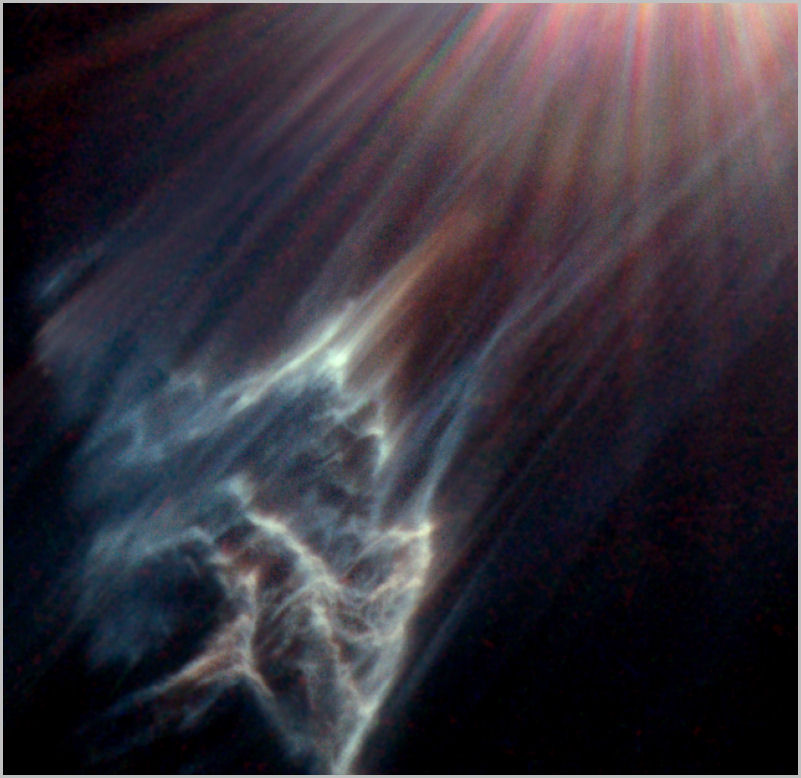
19 Tauri is named Taygeta, at magnitude 4.30 the dimmest of the six naked eye stars in the group. It is a close binary pair of B class blue subdwarfs that orbit each other every 3.6 years. Mythologically Taygeta was another conquest of Zeus, who fathered Lacedaemon by her, the founder of Sparta.
16 Tauri is named Celaeno, its magnitude of 5.45 putting it at the very limit of naked eye visibility, and possibly qualifying it as a modern day lost Pleiad. There is no myth attending her disappearance however, suggesting that in ancient times her star may have been brighter. Celaeno is a B7V blue main sequence star. Like her sister Alcyone, Celaeno was also seduced by Poseidon, and bore him three sons.
The faintest of the seven sisters is Sterope (also Asterope), beyond visual range for all but the most keen eyed observers, qualifying it as another modern day "lost Pleiade" (along with Celaeno), although there is no mention of its disappearance in ancient lore. A small telescope quickly reveals this sister to be two stars. 21 Tauri, Sterope I, is a B8V blue/white main sequence star with a magnitude of 5.76, and 22 Tauri, Sterope II, is an A0V blue/white main sequence star with a magnitude of 6.43. In myth Sterope was seduced by Ares (Mars) and bore him a son named Oinomaos.
27 Tauri carries the name of Atlas, father of the Pleiades, and at magnitude 3.62 second in brightness only to Alcyone. Although the names of the seven sisters were certainly applied to the stars in antiquity, R.H. Allen tells us the parent stars (Atlas and Pleione) were probably named in the seventeenth century. Atlas is a B7III blue giant, and appears to have a close binary companion as well as a more distant, dim companion, making it a triple star system.
The final member of the celestial family, 28 Tauri, is the mother Pleione, from whom the group derives its name. Like her youngest daughters Taygeta and Sterope, Pleione is not a giant, but a B8V blue/white main sequence star. At magnitude 5.05, and positioned right beside the much brighter Atlas, Pleione is virtually invisible without a telescope.
So far, we have found nine stars in the constellation of Taurus that host planetary systems, including the big, bright Ain (Epsilon Tauri) as mentioned above. As usual the other stars are too dim to see, and the planets are all gas giants, but two stars are noteworthy. The first is a G4V yellow main sequence star very much like our Sun, designated Gliese 209 (HD 37124). With a magnitude of 7.38 it can be found with a small telescope right beside the tip of the bull's southern horn, and it has not just one but at least three planets, all about half the size of Jupiter, located about 108 light years away.
The other planet hosting star, Gliese 176 (HD 285968), is important because it is very close, only 30.71 light years away. It is a very dim M2V red main sequence star with a magnitude of only 9.95, making it difficult to find. The planet that orbits it is one of the more reasonably sized planets, only about nine times larger than Earth.
For more information on these and other extrasolar planets, visit NASA's New Worlds Atlas, and The Open Exoplanets Catalogue.
Just inside the tip of the bull's lower horn is M1 - The Crab Nebula, the first object recorded by Charles Messier in his famous Messier Catalogue of 1784. Although most of the Messier Objects in his catalogue were later learned to be distant galaxies or dense clusters of far away stars, Messier's first entry, The Crab Nebula, is a true astronomical nebula: an immense cloud of gas and dust floating through the Cosmos. This particular nebula is the remnant of a giant star that ended its life in an explosion of unimaginable power called a supernova, in the year 1054 AD. At least that's when it was seen here on Earth and recorded by Chinese and other eastern observers. The nebula is 6,300 light years away.
After traveling through space/time for 6,300 years, when the light from the explosion finally reached Earth, it lit up the night sky, outshining everything but the Moon, and was even visible during the day. Over the next two years it gradually dimmed and retired from naked eye view, leaving behind an expanding cloud of gaseous debris known as a supernova remnant, that wouldn't be discovered until the invention of the telescope hundreds of years later.
At the centre of this still expanding cloud is what's left of the original star, a fearsome object almost beyond comprehension called a Pulsar. It is an object with twice the mass of our million mile wide Sun, yet only about 20 miles (30 kms) in diameter. This extreme density, achievable only through the power of a supernova, squeezes the electrons and protons right out of their atomic homes, leaving only the closely packed neutrons, forming what is known as a neutron star. This process causes the stellar core to spin at a highly accelerated rate, and release a huge amount of energy that is blasted out into space at regular intervals or pulses along the axes of rotation. When these axes are pointed towards Earth we pick them up, and the neutron star becomes a pulsar, the third most powerful known energy source in the Universe, after black holes and quasars.
The pulsar at the centre of The Crab Nebula spins 33 times a second, sending out 33 pulses a second, its highly compressed mass creating a gravitational field 100 billion times stronger than that of Earth. At magnitude 8.4, M1 is an excellent target for a small telescope.
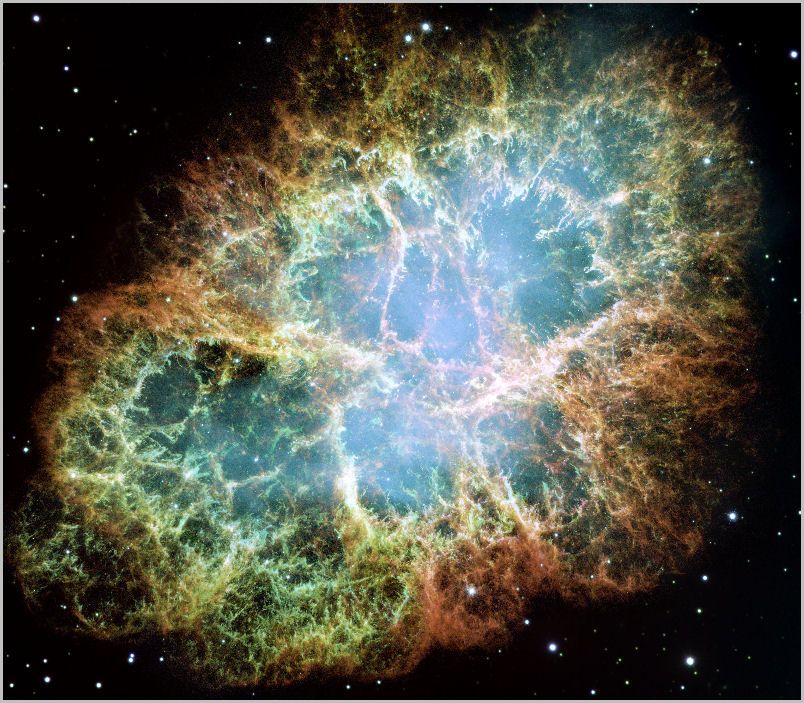
Over on the north edge of the constellation, on the border with Perseus, is a different kind of nebula called a planetary nebula. Resembling the disk of a planet through a small telescope, it is a bubble or sphere of gas that has been cast off by a dying star of average size, not large enough for a supernova. NASA gives us two views of the nebula below, in visible light on the left, and infrared on the right. From a distance of 800 light years, the nebula only manages a magnitude of 10.80, putting it out of range of most small telescopes.
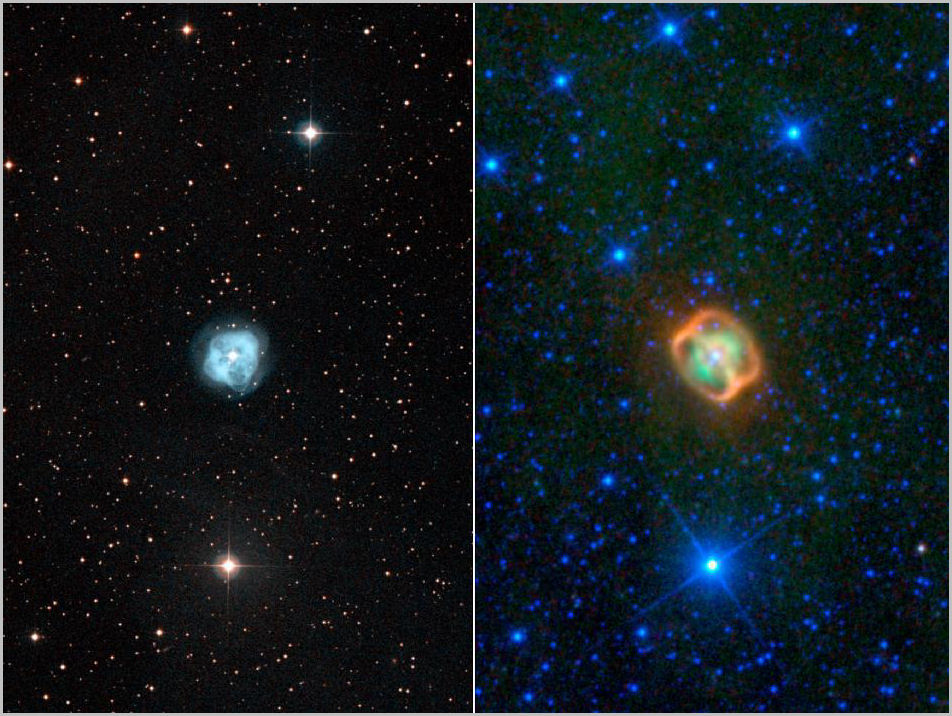
Taurus is also home to a much different kind of nebula, associated not with the death of stars, but with their birth. The northern part of the constellation contains a vast area full of clumps and strands of dark nebulae full of molecular hydrogen and helium, known as the Taurus Molecular Cloud (TMC), in which new stars are being born.
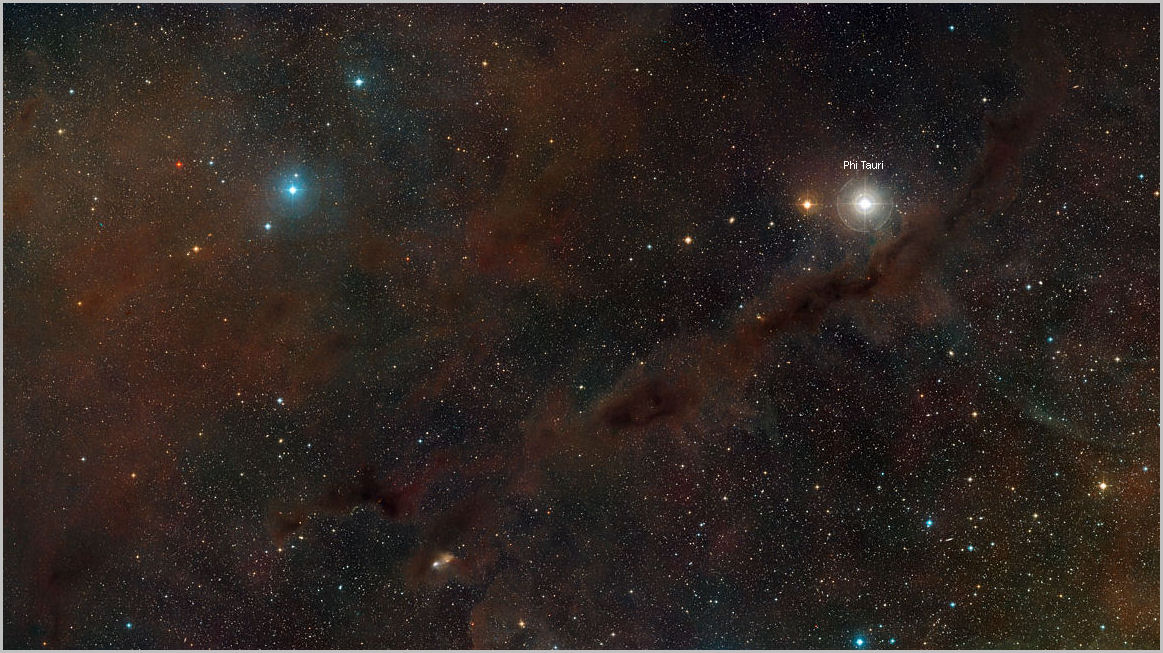
|
|
|
|
|
|